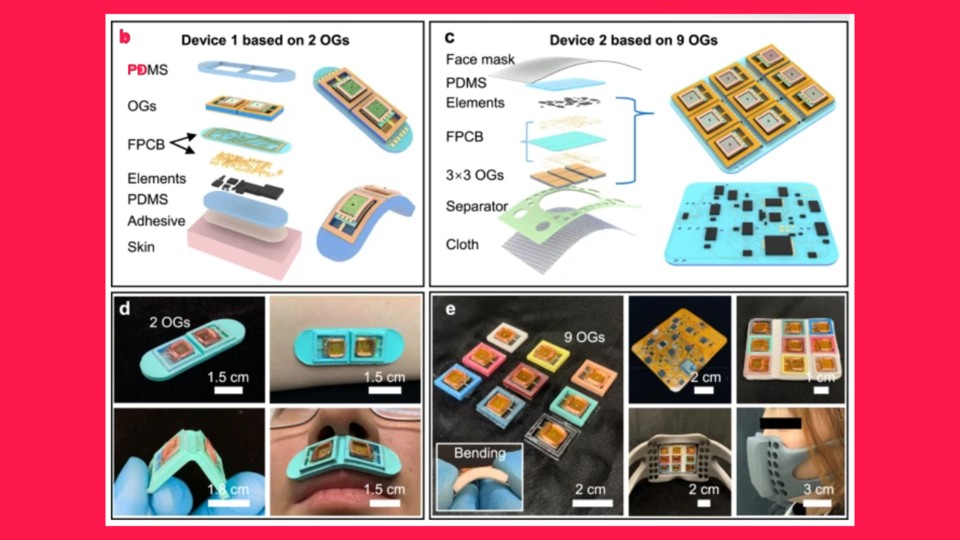What would Patrick Süskind’s “Perfume” be like as a VR experience? (Image sources: Apple; Danie Franco via Unsplash)
The most important things at a glance
- Odor-sensitive VR headsets: Researchers are developing technology for VR headsets like Apple Vision Pro to simulate smells.
- Advantages over previous approaches: Miniaturized scent generators under the nose enable real-time olfactory experience.
- Challenges and future: The technology is not yet fully developed, but more intense VR experiences with realistic scents are becoming apparent. Read more about this in our article.
In June the time had come: Apple finally presented its mixed reality glasses. A device that has been speculated about for what feels like an eternity.
The Apple Vision Pro is scheduled to appear next year and promises productive work; entertainment with music, videos and games; and social media and messaging.
Researchers from China are working on an extraordinary function that could enrich headsets like the Apple Vision Pro.
A specialist publication appears in “Nature Communications” describes the new technology as a “close-up olfactory feedback system” based on “a series of flexible and miniaturized odor generators for olfactory VR applications.”
Translated from technical Latin, this means: Computer chips serve as storage for fragrances. These are placed in the “mustache area” of the user – i.e. below the nose.
The researchers emphasize that their technology is generally suitable for mobile devices, but especially for virtual reality glasses.
But why should this method be better than previous attempts to marry the area of entertainment with the sense of smell?
To find out, let’s take a step back in history.
The invention of the olfactory cinema
What attempts have there been to date to create smells artificially?
There is the 1959 film “Behind the Great Wall.” He already used a technology called “AromaRama” to bring the scent film onto the screen and, well, under the nostrils. But decades earlier, in 1906, a certain Samuel “Roxy” Rothafel was twirling a piece of cotton infused with rose essence in front of a fan. In doing so, he spread the smell of roses among the audience – 21 years before the first sound film, “The Jazz Singers,” celebrated its premiere.
So you could say: the olfactory film was invented before the sound film.
But what does this have to do with the Apple Vision Pro or similar headsets?
How the sense of smell could work with VR glasses
Basically, it’s easy to combine film and smell. Fragrance must be released at the right time, for example when the film heroine smells a flower. The containers filled with the fragrances, which have to be placed underneath the cinema and the associated technology has to be installed in the cinema, are less light.
Applied to VR glasses, this would be at least impractical if you had to wear several scent containers on your nose with mixed reality glasses. That would be extremely impractical.
Appearance of our researchers.
Compared to the old “scent jar” approach, the method now being researched is said to offer several advantages. As I said, a computer chip is placed directly under the nose. The advantage of this: Due to the small distance between the nostrils and the chip, the amount of scent molecules to be released is kept comparatively small.
Illustration from the scientific article.
The other advantage is in the direction of “experiencing smells in real time”. Due to the minimal distance between the olfactory organ and the computer chip, you should be able to immediately perceive the odors released. In other words: Like in the olfactory cinema, you don’t have to wait for the molecules to float through the air – and finally screw themselves into your face.
The researchers estimate the speed of this method to be 1.44 seconds. That’s how long it should take from the “command to release the molecule” until the “fragrance molecule is actually released.”
Why the mixed reality headset with smell function is still a thing of the future
The research results give hope that you will soon be able to sniff “the smell of napalm in the morning” in the next Call of Duty or have sulfur blow up your nose in the penultimate ring of hell in Diablo 3 – even with VR glasses on your head.
However, it’s not quite that far yet – and the technology is by no means fully developed. This alone shows that the technology presented here can so far only produce nine different smells. In addition, the smells we perceive in everyday life overlap each other, creating a complex ménage of olfactory impressions. Wouldn’t a VR experience simply smell like a pushy salesperson in the perfumery department was plying you with clouds of scent?
However, research continues and, who knows, we might soon be sniffing out the fear sweat of our combatants during a game of Overwatch? Maybe clothespins will be in high demand among gamers and VR glasses so that they can manually pinch off the smell function.
If you would like to find out more about the Apple Vision Pro, please see our related articles.
Would you be happy about a smell function on mixed or virtual reality headsets? Or do you think that the failed Smell TV and Smell Cinema projects stinked – that’s why Smell-o-vision won’t work for an Apple Vision Pro? Please let us know your opinion in the comments.



 What’s happening with AI? Researcher explains why you can look forward to more creative NPCs, competition for ChatGPT and hot dog tomatoes
What’s happening with AI? Researcher explains why you can look forward to more creative NPCs, competition for ChatGPT and hot dog tomatoes Cowboy launches new on-demand service: That’s what’s inside
Cowboy launches new on-demand service: That’s what’s inside The new 4K Fire TV stick is now brutally reduced and transforms your old television into a smart TV
The new 4K Fire TV stick is now brutally reduced and transforms your old television into a smart TV The best mouse I’ve ever had, convinces me for gaming, work and home office and is different than all its predecessors!
The best mouse I’ve ever had, convinces me for gaming, work and home office and is different than all its predecessors! The first smart glasses suitable for everyday use that you can buy
The first smart glasses suitable for everyday use that you can buy